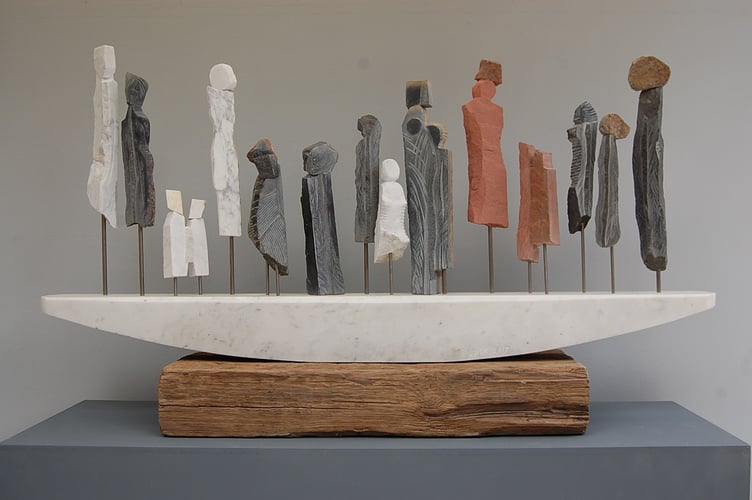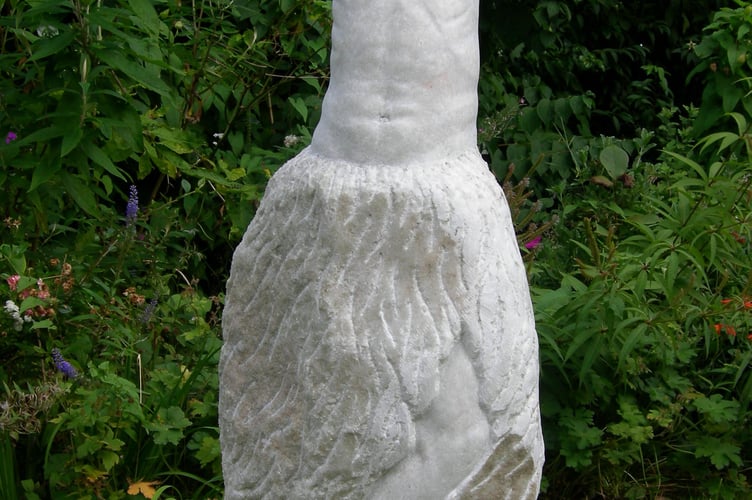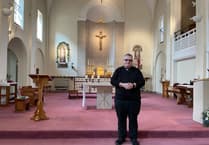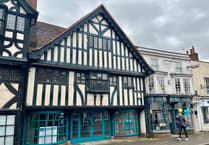A retrospective of Richard Jack’s illustrious career greeted me from the gate of his studio, almost 50 years of work starting in 1976 in Johannesburg, South Africa and Harare, Zimbabwe where it all began, to the present day in Farnham as part of Surrey Artists Open Studios this summer.
The son of an architect and nurse, Richard originally studied graphic design at Natal Technical Art College in Durban, working in advertising for three or four years before becoming a freelance illustrator, beginning to paint and sculpt at the same time.
He said: “I lost interest in the commercial world and wanted to do something more serious. My work was a lot more political because of the environment we were living in under apartheid. The expression of that came through in a series of roadside sculptures made with a mixture of urban and rural materials. In 1981 I moved back to Zimbabwe after independence.”
His earliest works on display - the large stone carved figureheads Survivor (1982), Strong Woman (1983) and Tortured (1985), abstract faces with sharp and soft contours of their facial features - seem thoughtful on their plinths, challenging the viewer as active observers.
Mixed media piece All At Sea (2017) reflects more recent turmoil and the plight of asylum seekers making perilous journeys by boat to the UK.
“The first world - it’s so complicated, with huge empires against one another. You wonder what’s going on sometimes, because it’s way beyond your control…there’s still that political influence in my work.”
Richard’s work explores the human condition throughout these pivotal moments in socio-political history, the adventure and struggles of what it is to be human, channelling his emotions through his practice. I asked if, during his long career, he felt more enlightened on the subject,
He replied: “No, every day changes - personally, socially, environmentally, politically and creating form within space.
“I think from meeting certain friends and artists, and so forth, they’ve had quite a strong influence on me in some cases. You don’t work in a vacuum and so that outside influence is really important.”
There’s a harmony in the materials Richard uses throughout his work - three basic materials predominantly, steel, wood and stone, that provide an underlying narrative connecting throughout. Looking at this collection, one sees how the forms and colours of the materials used create continuity enhancing the figure.
I asked about the process of creation for each piece, referencing the large Serpentine stone, wood and steel piece Children (1998).
“This piece is related to the children when they were quite small. I have an idea or vision when I start, and this was quite a nice piece of stone to work with as a group of figures, and then it was just a matter of raising the stone because I like to put it on rods to take the weight of the stone off the ground. I also have this continual looking for odd bits and pieces, and then gradually when the ideas come I pick and choose from this collection of odds and ends as they suit my work.
“I draw a lot, I think it’s important, I’ll often rough out an idea at the beginning and I sometimes draw the finished sculptures too, I’m constantly drawing in sketchbooks.”
Talking about the collection on display, Richard said: “There’s such a wide variety of my work here but it does give quite a clear picture of the various stages and styles that I’ve been through. As far as the actual influences behind the work, that’s more difficult because some of them really need to be discussed for each piece and each period.
“The continual mixture of wood, stone and steel has influenced me a lot, and also predominantly working with the figure, but not in an abstract way - it’s quite realistic. It’s just that it’s the way I work and the materials I use. I’m not really looking for reality, I’m looking for more expression in the actual work.
“I work with textures a lot, it’s so important to use textures - there’s a real tactile element to my work.”
Richard often works with Serpentine stone, native to Zimbabwe.
“Working with different tools like an angle grinder, chiselling or filing on Serpentine stone, you can create all these different textures. Some of it’s polished or left unpolished, and because it’s such close grains you can get these amazing details.”
The worked textures appear like a brushstroke or fineliner gliding spontaneously across the surface. His daughter Amber Barrett said: “One piece can have a lot of the rough, natural stone, and then it is super polished, smooth in others, creating a real contrast.” This is evident in Mary My Madonna (Serpentine, 2007) and Transformation (Serpentine and bronze, 2007).
Spiritually, types of Serpentine stone are considered to aid meditation, helping to clear a clouded mind. There is a sense of pensive thoughtfulness to these pieces, inviting the viewer to pause and reflect.
Figurative pieces created between 2010 and 2024, such as Family Ties (white marble, wood and steel, 2010), On the Land’ (Serpentine, steel and wood, 2007) and Levelling Up (wood, steel and Serpentine, 2003), all depict groups of figures and give a sense of community. Even solitary figures such as Introspection (white marble, 2011) feel as though they do not exist on their own, paired with the bronze casted twin next to them.
There’s a relationship between each period of works. They are never in isolation.
“I’ve always worked with several pieces at the same time so I don’t constantly work on one piece, I work on one and then leave it and go on to another piece or go back to an older piece and work on that for a while. But in the meantime I’m always looking at the other new pieces; I’ve got them in my mind all the time and I see them under different lights and conditions and so they develop organically.
“I work quite spontaneously - the wood panel series, for instance, that I started a few years ago and then gradually started to add to as ideas came or as I found pieces that I played around with. They all developed into landscapes.”
The wood panel series feels like a full circle moment, hanging on the studio wall, where above two of Richard’s earlier paintings hang on the ceiling. The panels explore where sculpture meets painting. They reminded me of the abstract desert landscape of Dali’s The Persistence of Memory to some extent. Mixed media pieces such as Sculptor’s Studio, Melting Moon and The Golden Bough - all created in 2023 and 2024 - capture spaces where imagination and reality meet.
“More recently I've been working on a lot more marble pieces. Marble is very hard to work, you can create textures but not quite as spontaneously.” There’s a permanence to the white marble works that differs from the relative fluidity of Serpentine and earlier works, punctuating an indelible sculptural legacy that I had the privilege of viewing. As I turned to wave goodbye to Richard and his family at the gate, I felt the sense of connection between family and community that so many of his works convey, and how lucky I am to have felt a brief moment of that connection.







Comments
This article has no comments yet. Be the first to leave a comment.